EAL Teaching Strategies: A Reflective Journal on Intercultural Aspects
VerifiedAdded on 2023/04/21
|10
|2558
|418
Journal and Reflective Writing
AI Summary
This assignment is a professional learning journal reflecting on observations and experiences related to teaching English as an Additional Language/Dialect (EAL/D) students. It addresses unconscious biases, knowledge gaps in teaching and learning, intercultural aspects, and the role of family and community in language learning. The journal includes a discussion of intercultural interactions, emphasizing the importance of cultural diversity and understanding in the classroom. It evaluates an activity posted on a discussion board and suggests improvements. The journal also presents an activity applying principles of teaching standard Australian written English to speakers of other languages and dialects, focusing on oral language development through film analysis and class discussions. The conclusion highlights the need to encourage competency in students' first language alongside English, promoting collaborative and interactive teaching strategies to enhance learning experiences.
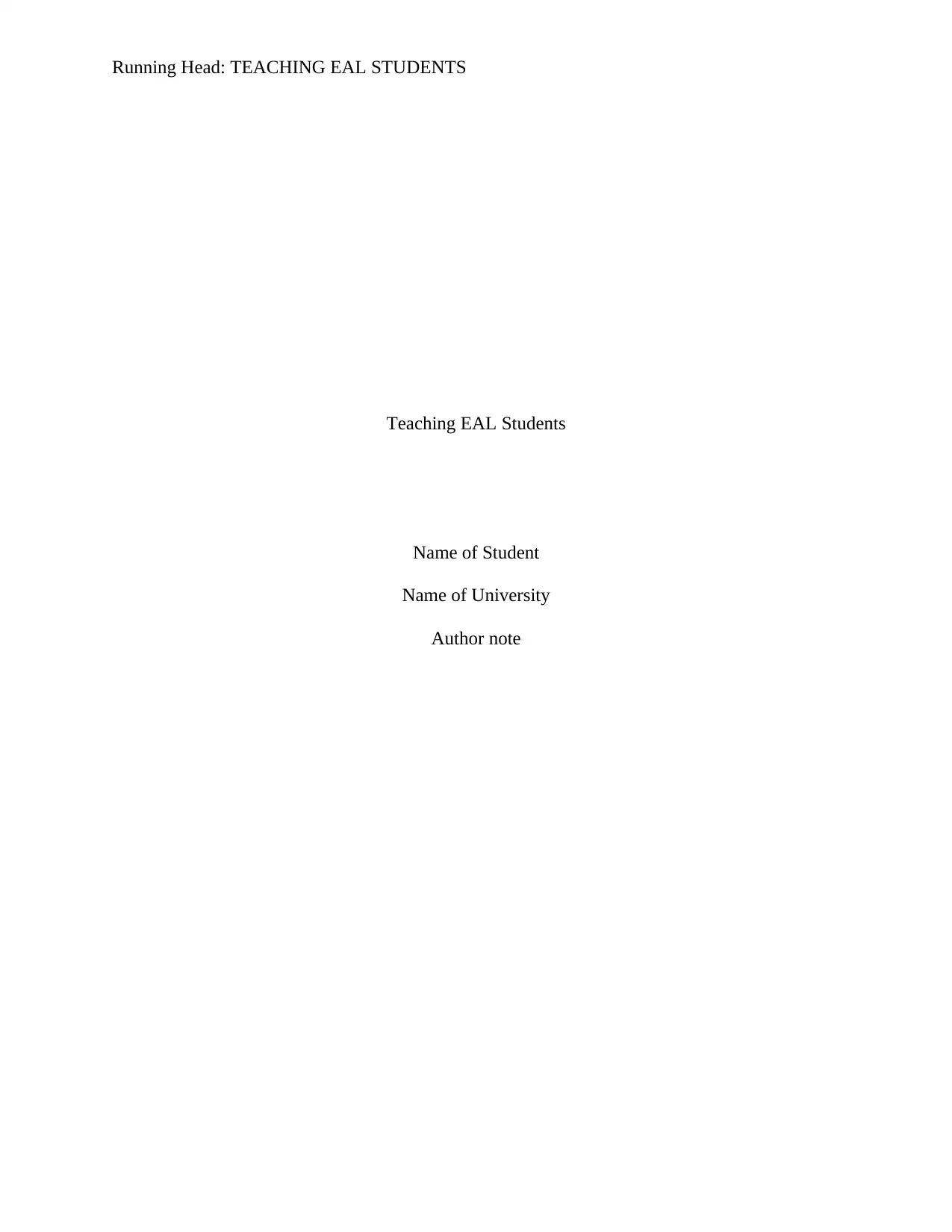
Running Head: TEACHING EAL STUDENTS
Teaching EAL Students
Name of Student
Name of University
Author note
Teaching EAL Students
Name of Student
Name of University
Author note
Paraphrase This Document
Need a fresh take? Get an instant paraphrase of this document with our AI Paraphraser
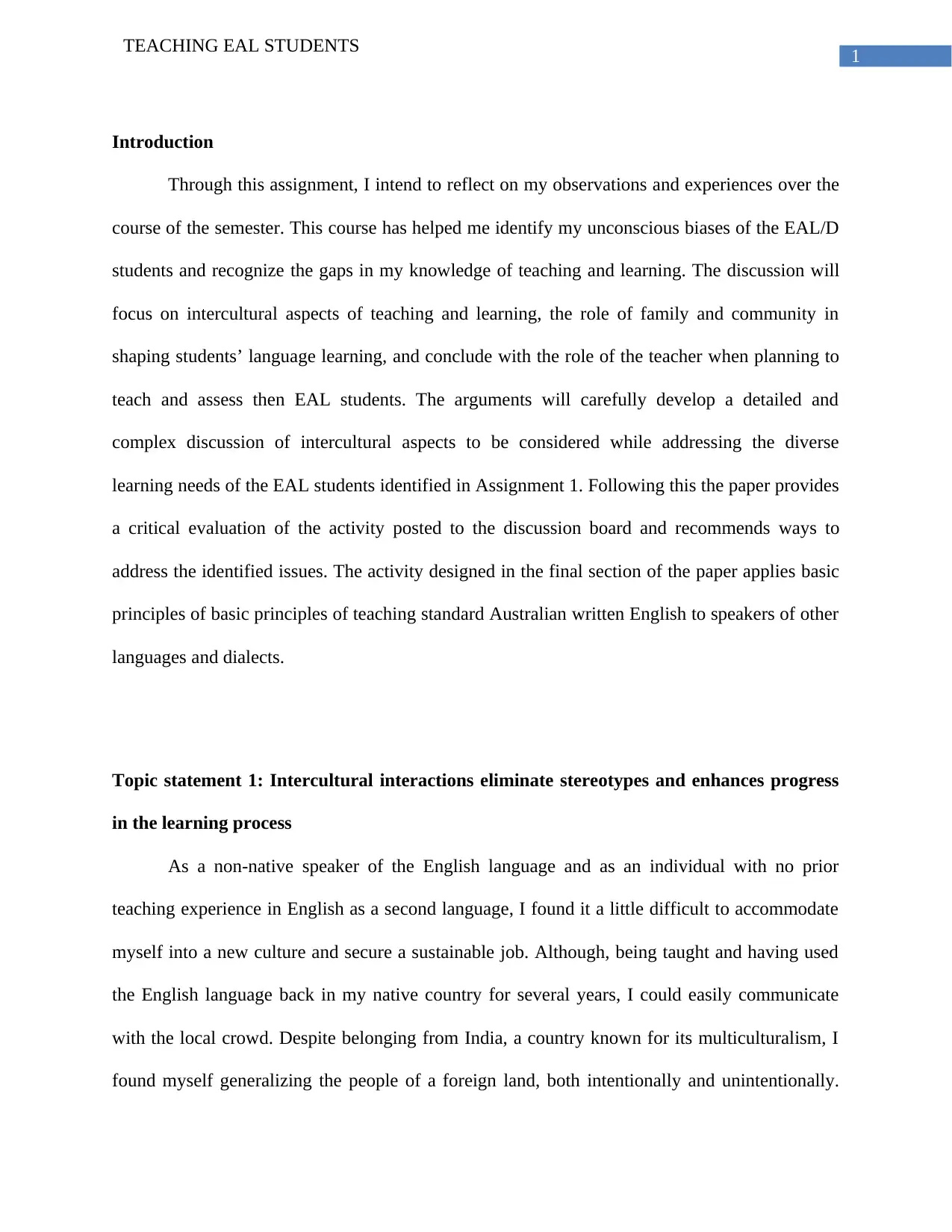
1
TEACHING EAL STUDENTS
Introduction
Through this assignment, I intend to reflect on my observations and experiences over the
course of the semester. This course has helped me identify my unconscious biases of the EAL/D
students and recognize the gaps in my knowledge of teaching and learning. The discussion will
focus on intercultural aspects of teaching and learning, the role of family and community in
shaping students’ language learning, and conclude with the role of the teacher when planning to
teach and assess then EAL students. The arguments will carefully develop a detailed and
complex discussion of intercultural aspects to be considered while addressing the diverse
learning needs of the EAL students identified in Assignment 1. Following this the paper provides
a critical evaluation of the activity posted to the discussion board and recommends ways to
address the identified issues. The activity designed in the final section of the paper applies basic
principles of basic principles of teaching standard Australian written English to speakers of other
languages and dialects.
Topic statement 1: Intercultural interactions eliminate stereotypes and enhances progress
in the learning process
As a non-native speaker of the English language and as an individual with no prior
teaching experience in English as a second language, I found it a little difficult to accommodate
myself into a new culture and secure a sustainable job. Although, being taught and having used
the English language back in my native country for several years, I could easily communicate
with the local crowd. Despite belonging from India, a country known for its multiculturalism, I
found myself generalizing the people of a foreign land, both intentionally and unintentionally.
TEACHING EAL STUDENTS
Introduction
Through this assignment, I intend to reflect on my observations and experiences over the
course of the semester. This course has helped me identify my unconscious biases of the EAL/D
students and recognize the gaps in my knowledge of teaching and learning. The discussion will
focus on intercultural aspects of teaching and learning, the role of family and community in
shaping students’ language learning, and conclude with the role of the teacher when planning to
teach and assess then EAL students. The arguments will carefully develop a detailed and
complex discussion of intercultural aspects to be considered while addressing the diverse
learning needs of the EAL students identified in Assignment 1. Following this the paper provides
a critical evaluation of the activity posted to the discussion board and recommends ways to
address the identified issues. The activity designed in the final section of the paper applies basic
principles of basic principles of teaching standard Australian written English to speakers of other
languages and dialects.
Topic statement 1: Intercultural interactions eliminate stereotypes and enhances progress
in the learning process
As a non-native speaker of the English language and as an individual with no prior
teaching experience in English as a second language, I found it a little difficult to accommodate
myself into a new culture and secure a sustainable job. Although, being taught and having used
the English language back in my native country for several years, I could easily communicate
with the local crowd. Despite belonging from India, a country known for its multiculturalism, I
found myself generalizing the people of a foreign land, both intentionally and unintentionally.
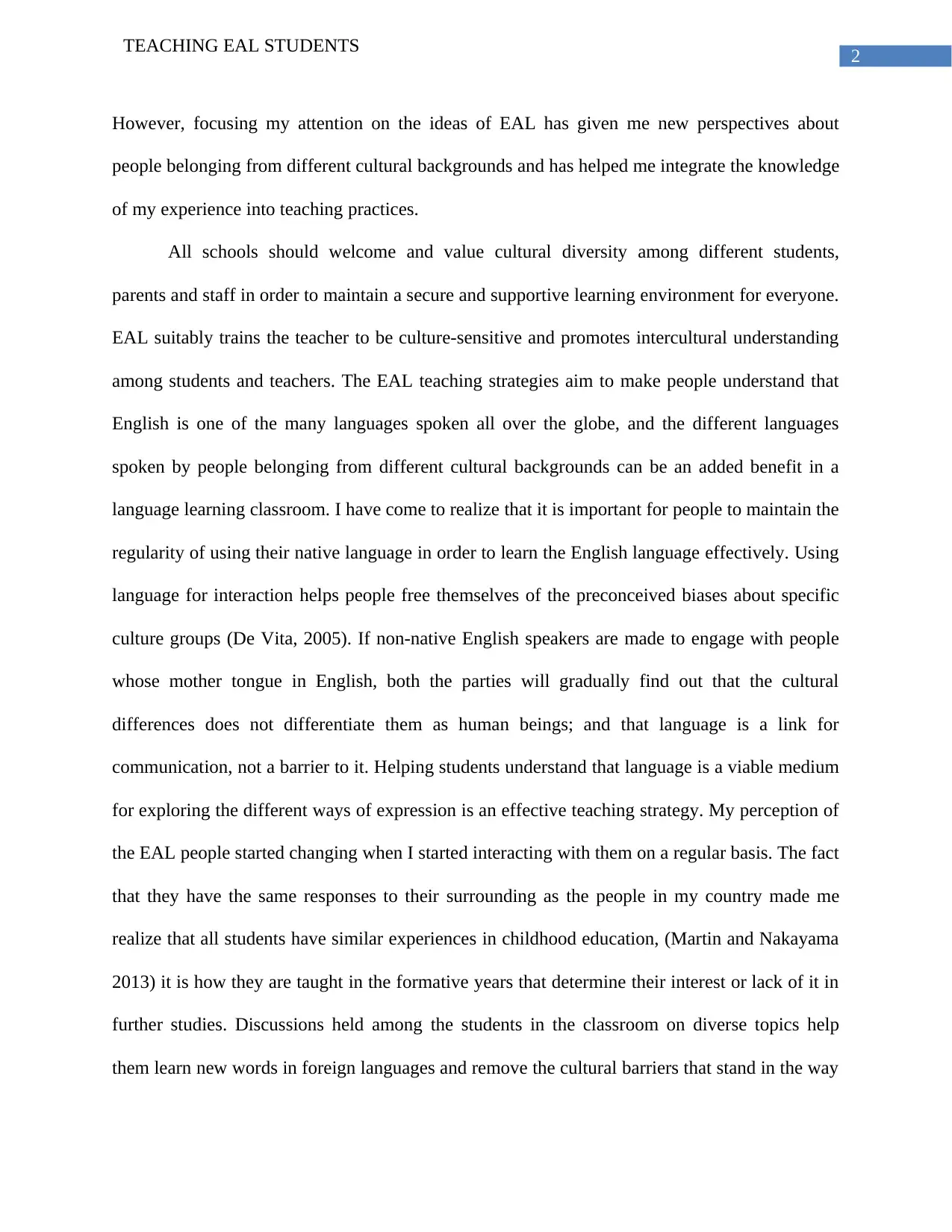
2
TEACHING EAL STUDENTS
However, focusing my attention on the ideas of EAL has given me new perspectives about
people belonging from different cultural backgrounds and has helped me integrate the knowledge
of my experience into teaching practices.
All schools should welcome and value cultural diversity among different students,
parents and staff in order to maintain a secure and supportive learning environment for everyone.
EAL suitably trains the teacher to be culture-sensitive and promotes intercultural understanding
among students and teachers. The EAL teaching strategies aim to make people understand that
English is one of the many languages spoken all over the globe, and the different languages
spoken by people belonging from different cultural backgrounds can be an added benefit in a
language learning classroom. I have come to realize that it is important for people to maintain the
regularity of using their native language in order to learn the English language effectively. Using
language for interaction helps people free themselves of the preconceived biases about specific
culture groups (De Vita, 2005). If non-native English speakers are made to engage with people
whose mother tongue in English, both the parties will gradually find out that the cultural
differences does not differentiate them as human beings; and that language is a link for
communication, not a barrier to it. Helping students understand that language is a viable medium
for exploring the different ways of expression is an effective teaching strategy. My perception of
the EAL people started changing when I started interacting with them on a regular basis. The fact
that they have the same responses to their surrounding as the people in my country made me
realize that all students have similar experiences in childhood education, (Martin and Nakayama
2013) it is how they are taught in the formative years that determine their interest or lack of it in
further studies. Discussions held among the students in the classroom on diverse topics help
them learn new words in foreign languages and remove the cultural barriers that stand in the way
TEACHING EAL STUDENTS
However, focusing my attention on the ideas of EAL has given me new perspectives about
people belonging from different cultural backgrounds and has helped me integrate the knowledge
of my experience into teaching practices.
All schools should welcome and value cultural diversity among different students,
parents and staff in order to maintain a secure and supportive learning environment for everyone.
EAL suitably trains the teacher to be culture-sensitive and promotes intercultural understanding
among students and teachers. The EAL teaching strategies aim to make people understand that
English is one of the many languages spoken all over the globe, and the different languages
spoken by people belonging from different cultural backgrounds can be an added benefit in a
language learning classroom. I have come to realize that it is important for people to maintain the
regularity of using their native language in order to learn the English language effectively. Using
language for interaction helps people free themselves of the preconceived biases about specific
culture groups (De Vita, 2005). If non-native English speakers are made to engage with people
whose mother tongue in English, both the parties will gradually find out that the cultural
differences does not differentiate them as human beings; and that language is a link for
communication, not a barrier to it. Helping students understand that language is a viable medium
for exploring the different ways of expression is an effective teaching strategy. My perception of
the EAL people started changing when I started interacting with them on a regular basis. The fact
that they have the same responses to their surrounding as the people in my country made me
realize that all students have similar experiences in childhood education, (Martin and Nakayama
2013) it is how they are taught in the formative years that determine their interest or lack of it in
further studies. Discussions held among the students in the classroom on diverse topics help
them learn new words in foreign languages and remove the cultural barriers that stand in the way
⊘ This is a preview!⊘
Do you want full access?
Subscribe today to unlock all pages.

Trusted by 1+ million students worldwide
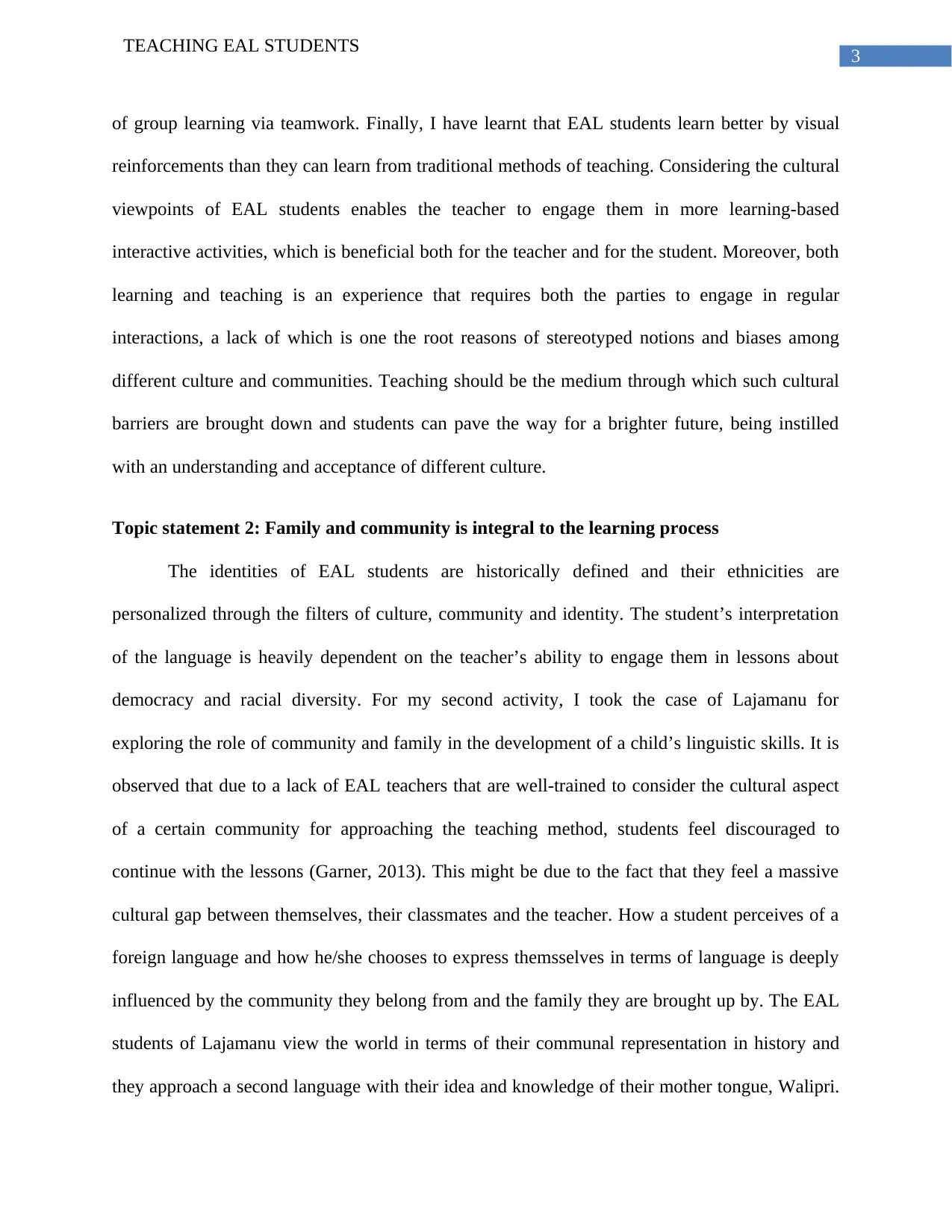
3
TEACHING EAL STUDENTS
of group learning via teamwork. Finally, I have learnt that EAL students learn better by visual
reinforcements than they can learn from traditional methods of teaching. Considering the cultural
viewpoints of EAL students enables the teacher to engage them in more learning-based
interactive activities, which is beneficial both for the teacher and for the student. Moreover, both
learning and teaching is an experience that requires both the parties to engage in regular
interactions, a lack of which is one the root reasons of stereotyped notions and biases among
different culture and communities. Teaching should be the medium through which such cultural
barriers are brought down and students can pave the way for a brighter future, being instilled
with an understanding and acceptance of different culture.
Topic statement 2: Family and community is integral to the learning process
The identities of EAL students are historically defined and their ethnicities are
personalized through the filters of culture, community and identity. The student’s interpretation
of the language is heavily dependent on the teacher’s ability to engage them in lessons about
democracy and racial diversity. For my second activity, I took the case of Lajamanu for
exploring the role of community and family in the development of a child’s linguistic skills. It is
observed that due to a lack of EAL teachers that are well-trained to consider the cultural aspect
of a certain community for approaching the teaching method, students feel discouraged to
continue with the lessons (Garner, 2013). This might be due to the fact that they feel a massive
cultural gap between themselves, their classmates and the teacher. How a student perceives of a
foreign language and how he/she chooses to express themsselves in terms of language is deeply
influenced by the community they belong from and the family they are brought up by. The EAL
students of Lajamanu view the world in terms of their communal representation in history and
they approach a second language with their idea and knowledge of their mother tongue, Walipri.
TEACHING EAL STUDENTS
of group learning via teamwork. Finally, I have learnt that EAL students learn better by visual
reinforcements than they can learn from traditional methods of teaching. Considering the cultural
viewpoints of EAL students enables the teacher to engage them in more learning-based
interactive activities, which is beneficial both for the teacher and for the student. Moreover, both
learning and teaching is an experience that requires both the parties to engage in regular
interactions, a lack of which is one the root reasons of stereotyped notions and biases among
different culture and communities. Teaching should be the medium through which such cultural
barriers are brought down and students can pave the way for a brighter future, being instilled
with an understanding and acceptance of different culture.
Topic statement 2: Family and community is integral to the learning process
The identities of EAL students are historically defined and their ethnicities are
personalized through the filters of culture, community and identity. The student’s interpretation
of the language is heavily dependent on the teacher’s ability to engage them in lessons about
democracy and racial diversity. For my second activity, I took the case of Lajamanu for
exploring the role of community and family in the development of a child’s linguistic skills. It is
observed that due to a lack of EAL teachers that are well-trained to consider the cultural aspect
of a certain community for approaching the teaching method, students feel discouraged to
continue with the lessons (Garner, 2013). This might be due to the fact that they feel a massive
cultural gap between themselves, their classmates and the teacher. How a student perceives of a
foreign language and how he/she chooses to express themsselves in terms of language is deeply
influenced by the community they belong from and the family they are brought up by. The EAL
students of Lajamanu view the world in terms of their communal representation in history and
they approach a second language with their idea and knowledge of their mother tongue, Walipri.
Paraphrase This Document
Need a fresh take? Get an instant paraphrase of this document with our AI Paraphraser
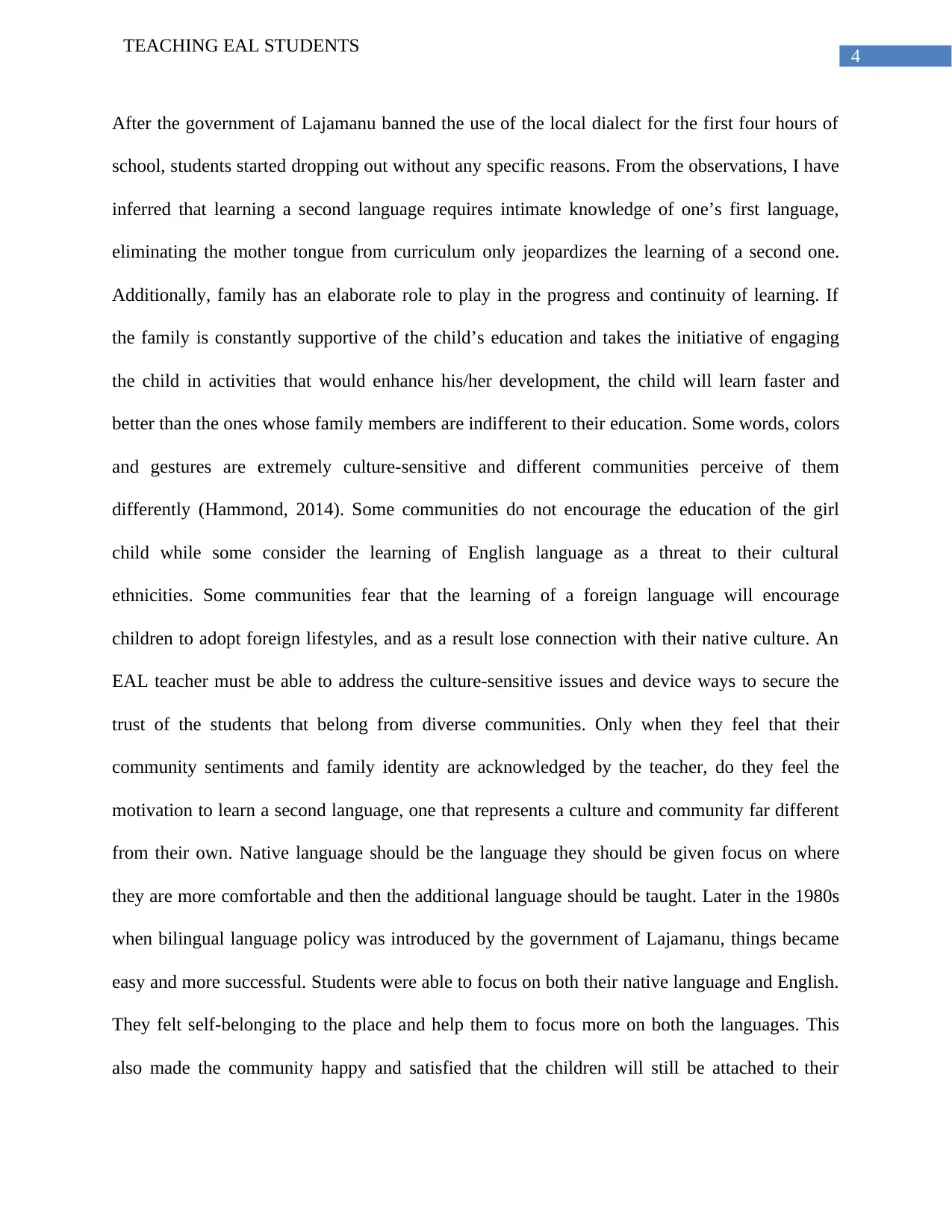
4
TEACHING EAL STUDENTS
After the government of Lajamanu banned the use of the local dialect for the first four hours of
school, students started dropping out without any specific reasons. From the observations, I have
inferred that learning a second language requires intimate knowledge of one’s first language,
eliminating the mother tongue from curriculum only jeopardizes the learning of a second one.
Additionally, family has an elaborate role to play in the progress and continuity of learning. If
the family is constantly supportive of the child’s education and takes the initiative of engaging
the child in activities that would enhance his/her development, the child will learn faster and
better than the ones whose family members are indifferent to their education. Some words, colors
and gestures are extremely culture-sensitive and different communities perceive of them
differently (Hammond, 2014). Some communities do not encourage the education of the girl
child while some consider the learning of English language as a threat to their cultural
ethnicities. Some communities fear that the learning of a foreign language will encourage
children to adopt foreign lifestyles, and as a result lose connection with their native culture. An
EAL teacher must be able to address the culture-sensitive issues and device ways to secure the
trust of the students that belong from diverse communities. Only when they feel that their
community sentiments and family identity are acknowledged by the teacher, do they feel the
motivation to learn a second language, one that represents a culture and community far different
from their own. Native language should be the language they should be given focus on where
they are more comfortable and then the additional language should be taught. Later in the 1980s
when bilingual language policy was introduced by the government of Lajamanu, things became
easy and more successful. Students were able to focus on both their native language and English.
They felt self-belonging to the place and help them to focus more on both the languages. This
also made the community happy and satisfied that the children will still be attached to their
TEACHING EAL STUDENTS
After the government of Lajamanu banned the use of the local dialect for the first four hours of
school, students started dropping out without any specific reasons. From the observations, I have
inferred that learning a second language requires intimate knowledge of one’s first language,
eliminating the mother tongue from curriculum only jeopardizes the learning of a second one.
Additionally, family has an elaborate role to play in the progress and continuity of learning. If
the family is constantly supportive of the child’s education and takes the initiative of engaging
the child in activities that would enhance his/her development, the child will learn faster and
better than the ones whose family members are indifferent to their education. Some words, colors
and gestures are extremely culture-sensitive and different communities perceive of them
differently (Hammond, 2014). Some communities do not encourage the education of the girl
child while some consider the learning of English language as a threat to their cultural
ethnicities. Some communities fear that the learning of a foreign language will encourage
children to adopt foreign lifestyles, and as a result lose connection with their native culture. An
EAL teacher must be able to address the culture-sensitive issues and device ways to secure the
trust of the students that belong from diverse communities. Only when they feel that their
community sentiments and family identity are acknowledged by the teacher, do they feel the
motivation to learn a second language, one that represents a culture and community far different
from their own. Native language should be the language they should be given focus on where
they are more comfortable and then the additional language should be taught. Later in the 1980s
when bilingual language policy was introduced by the government of Lajamanu, things became
easy and more successful. Students were able to focus on both their native language and English.
They felt self-belonging to the place and help them to focus more on both the languages. This
also made the community happy and satisfied that the children will still be attached to their
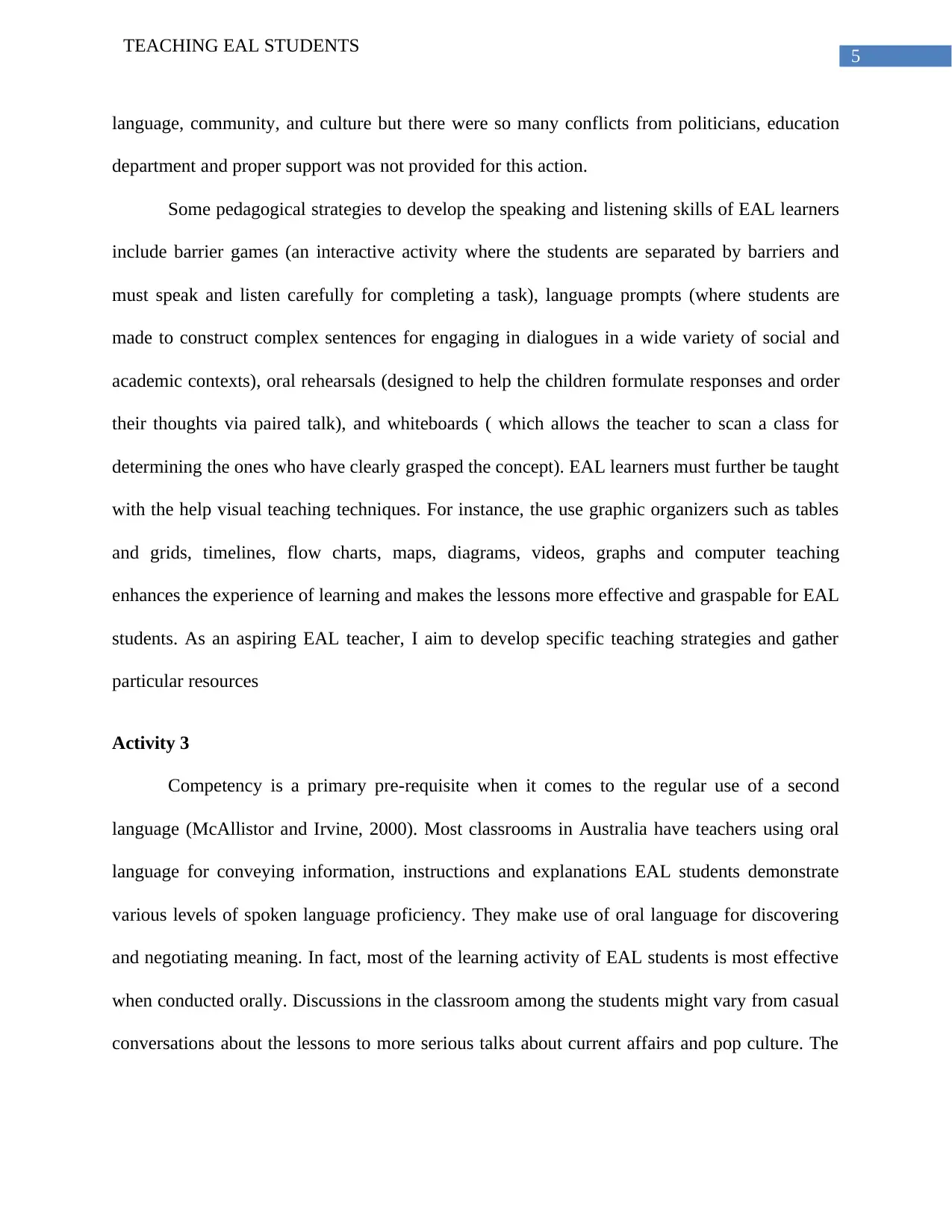
5
TEACHING EAL STUDENTS
language, community, and culture but there were so many conflicts from politicians, education
department and proper support was not provided for this action.
Some pedagogical strategies to develop the speaking and listening skills of EAL learners
include barrier games (an interactive activity where the students are separated by barriers and
must speak and listen carefully for completing a task), language prompts (where students are
made to construct complex sentences for engaging in dialogues in a wide variety of social and
academic contexts), oral rehearsals (designed to help the children formulate responses and order
their thoughts via paired talk), and whiteboards ( which allows the teacher to scan a class for
determining the ones who have clearly grasped the concept). EAL learners must further be taught
with the help visual teaching techniques. For instance, the use graphic organizers such as tables
and grids, timelines, flow charts, maps, diagrams, videos, graphs and computer teaching
enhances the experience of learning and makes the lessons more effective and graspable for EAL
students. As an aspiring EAL teacher, I aim to develop specific teaching strategies and gather
particular resources
Activity 3
Competency is a primary pre-requisite when it comes to the regular use of a second
language (McAllistor and Irvine, 2000). Most classrooms in Australia have teachers using oral
language for conveying information, instructions and explanations EAL students demonstrate
various levels of spoken language proficiency. They make use of oral language for discovering
and negotiating meaning. In fact, most of the learning activity of EAL students is most effective
when conducted orally. Discussions in the classroom among the students might vary from casual
conversations about the lessons to more serious talks about current affairs and pop culture. The
TEACHING EAL STUDENTS
language, community, and culture but there were so many conflicts from politicians, education
department and proper support was not provided for this action.
Some pedagogical strategies to develop the speaking and listening skills of EAL learners
include barrier games (an interactive activity where the students are separated by barriers and
must speak and listen carefully for completing a task), language prompts (where students are
made to construct complex sentences for engaging in dialogues in a wide variety of social and
academic contexts), oral rehearsals (designed to help the children formulate responses and order
their thoughts via paired talk), and whiteboards ( which allows the teacher to scan a class for
determining the ones who have clearly grasped the concept). EAL learners must further be taught
with the help visual teaching techniques. For instance, the use graphic organizers such as tables
and grids, timelines, flow charts, maps, diagrams, videos, graphs and computer teaching
enhances the experience of learning and makes the lessons more effective and graspable for EAL
students. As an aspiring EAL teacher, I aim to develop specific teaching strategies and gather
particular resources
Activity 3
Competency is a primary pre-requisite when it comes to the regular use of a second
language (McAllistor and Irvine, 2000). Most classrooms in Australia have teachers using oral
language for conveying information, instructions and explanations EAL students demonstrate
various levels of spoken language proficiency. They make use of oral language for discovering
and negotiating meaning. In fact, most of the learning activity of EAL students is most effective
when conducted orally. Discussions in the classroom among the students might vary from casual
conversations about the lessons to more serious talks about current affairs and pop culture. The
⊘ This is a preview!⊘
Do you want full access?
Subscribe today to unlock all pages.

Trusted by 1+ million students worldwide
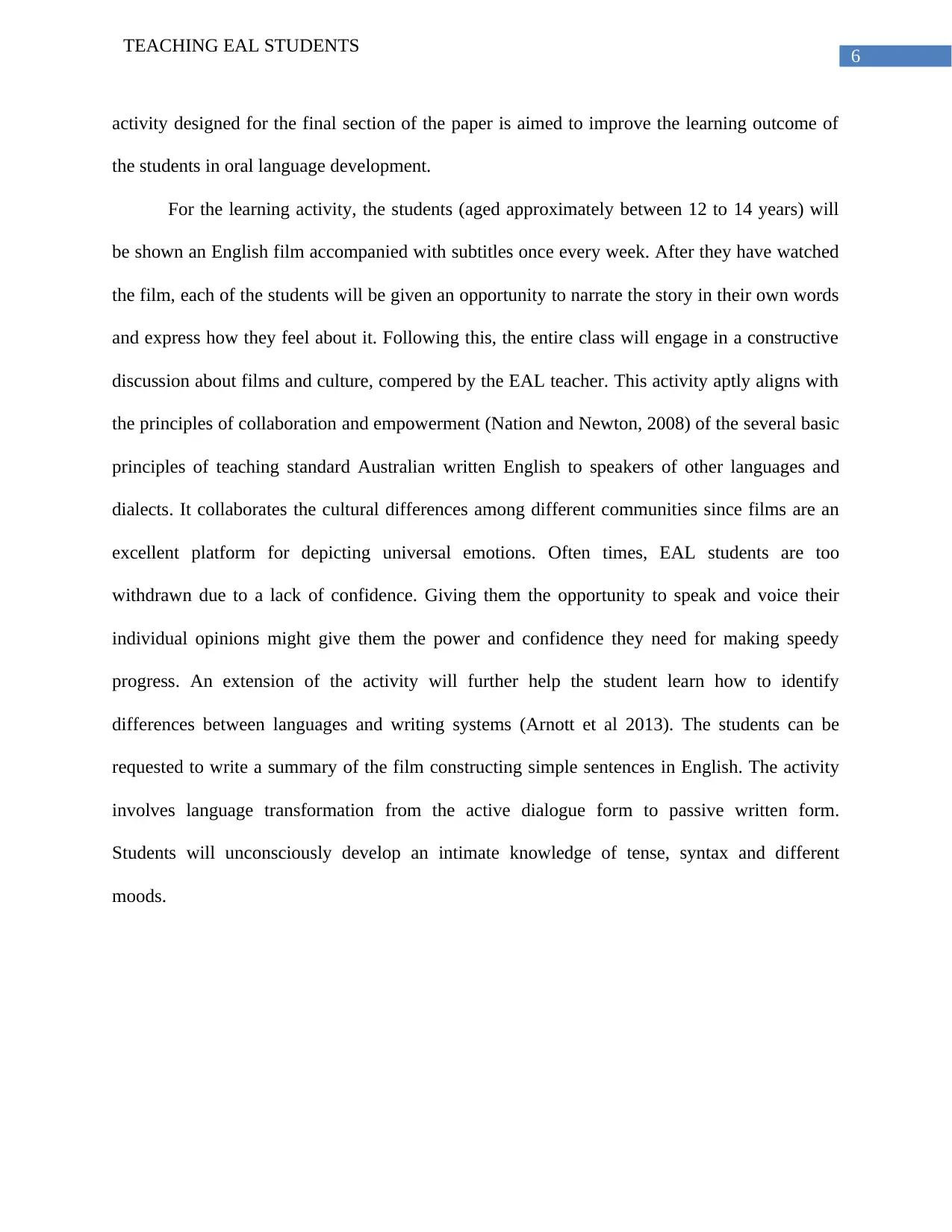
6
TEACHING EAL STUDENTS
activity designed for the final section of the paper is aimed to improve the learning outcome of
the students in oral language development.
For the learning activity, the students (aged approximately between 12 to 14 years) will
be shown an English film accompanied with subtitles once every week. After they have watched
the film, each of the students will be given an opportunity to narrate the story in their own words
and express how they feel about it. Following this, the entire class will engage in a constructive
discussion about films and culture, compered by the EAL teacher. This activity aptly aligns with
the principles of collaboration and empowerment (Nation and Newton, 2008) of the several basic
principles of teaching standard Australian written English to speakers of other languages and
dialects. It collaborates the cultural differences among different communities since films are an
excellent platform for depicting universal emotions. Often times, EAL students are too
withdrawn due to a lack of confidence. Giving them the opportunity to speak and voice their
individual opinions might give them the power and confidence they need for making speedy
progress. An extension of the activity will further help the student learn how to identify
differences between languages and writing systems (Arnott et al 2013). The students can be
requested to write a summary of the film constructing simple sentences in English. The activity
involves language transformation from the active dialogue form to passive written form.
Students will unconsciously develop an intimate knowledge of tense, syntax and different
moods.
TEACHING EAL STUDENTS
activity designed for the final section of the paper is aimed to improve the learning outcome of
the students in oral language development.
For the learning activity, the students (aged approximately between 12 to 14 years) will
be shown an English film accompanied with subtitles once every week. After they have watched
the film, each of the students will be given an opportunity to narrate the story in their own words
and express how they feel about it. Following this, the entire class will engage in a constructive
discussion about films and culture, compered by the EAL teacher. This activity aptly aligns with
the principles of collaboration and empowerment (Nation and Newton, 2008) of the several basic
principles of teaching standard Australian written English to speakers of other languages and
dialects. It collaborates the cultural differences among different communities since films are an
excellent platform for depicting universal emotions. Often times, EAL students are too
withdrawn due to a lack of confidence. Giving them the opportunity to speak and voice their
individual opinions might give them the power and confidence they need for making speedy
progress. An extension of the activity will further help the student learn how to identify
differences between languages and writing systems (Arnott et al 2013). The students can be
requested to write a summary of the film constructing simple sentences in English. The activity
involves language transformation from the active dialogue form to passive written form.
Students will unconsciously develop an intimate knowledge of tense, syntax and different
moods.
Paraphrase This Document
Need a fresh take? Get an instant paraphrase of this document with our AI Paraphraser
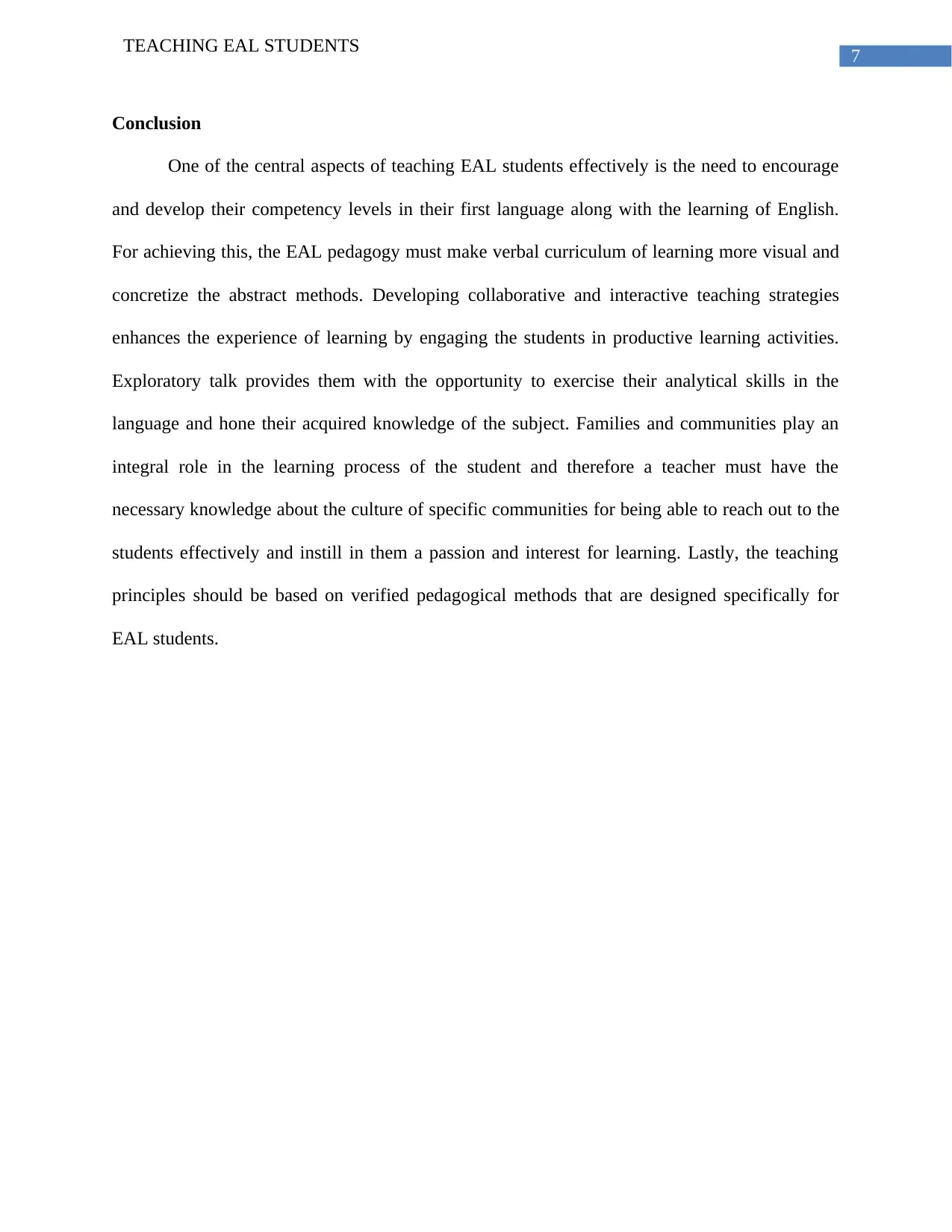
7
TEACHING EAL STUDENTS
Conclusion
One of the central aspects of teaching EAL students effectively is the need to encourage
and develop their competency levels in their first language along with the learning of English.
For achieving this, the EAL pedagogy must make verbal curriculum of learning more visual and
concretize the abstract methods. Developing collaborative and interactive teaching strategies
enhances the experience of learning by engaging the students in productive learning activities.
Exploratory talk provides them with the opportunity to exercise their analytical skills in the
language and hone their acquired knowledge of the subject. Families and communities play an
integral role in the learning process of the student and therefore a teacher must have the
necessary knowledge about the culture of specific communities for being able to reach out to the
students effectively and instill in them a passion and interest for learning. Lastly, the teaching
principles should be based on verified pedagogical methods that are designed specifically for
EAL students.
TEACHING EAL STUDENTS
Conclusion
One of the central aspects of teaching EAL students effectively is the need to encourage
and develop their competency levels in their first language along with the learning of English.
For achieving this, the EAL pedagogy must make verbal curriculum of learning more visual and
concretize the abstract methods. Developing collaborative and interactive teaching strategies
enhances the experience of learning by engaging the students in productive learning activities.
Exploratory talk provides them with the opportunity to exercise their analytical skills in the
language and hone their acquired knowledge of the subject. Families and communities play an
integral role in the learning process of the student and therefore a teacher must have the
necessary knowledge about the culture of specific communities for being able to reach out to the
students effectively and instill in them a passion and interest for learning. Lastly, the teaching
principles should be based on verified pedagogical methods that are designed specifically for
EAL students.
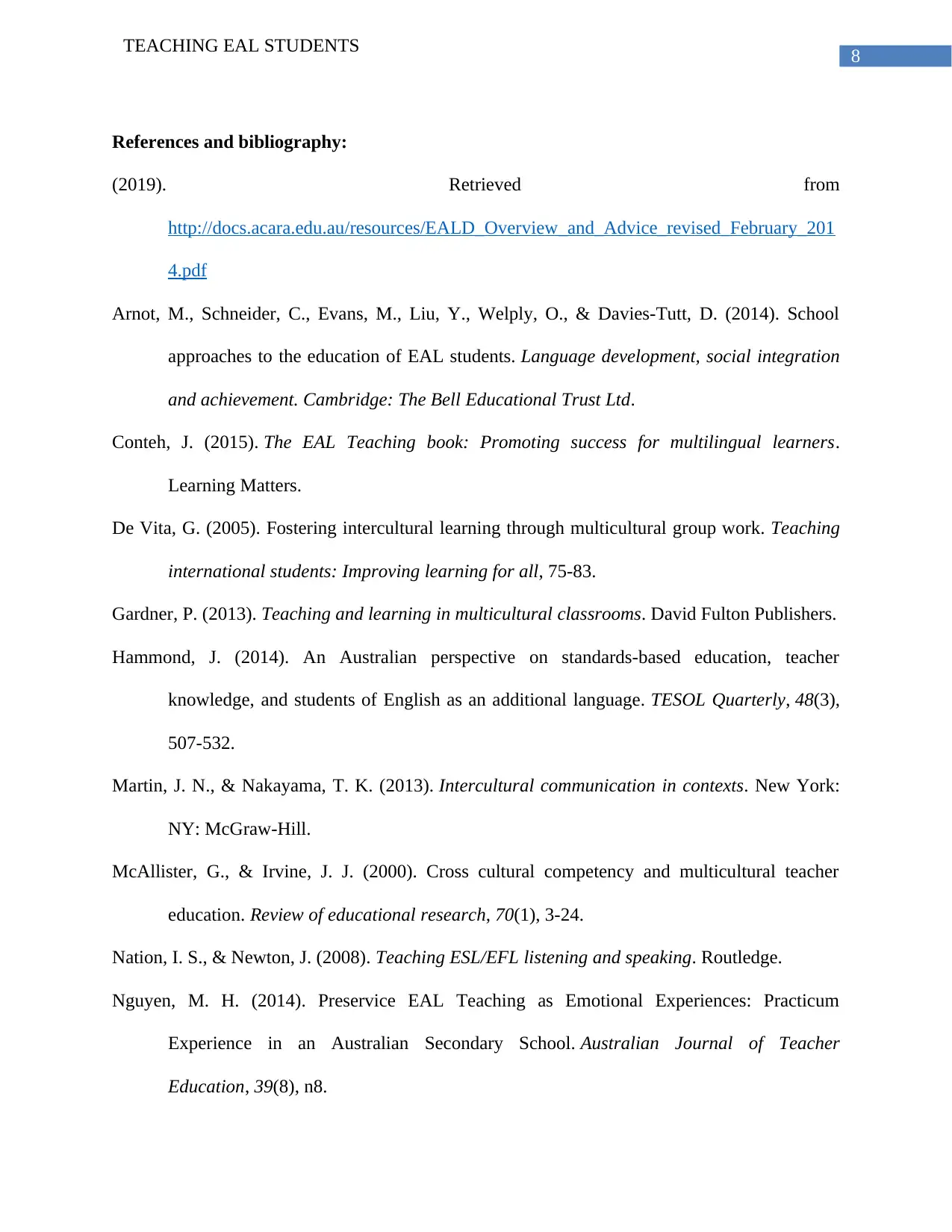
8
TEACHING EAL STUDENTS
References and bibliography:
(2019). Retrieved from
http://docs.acara.edu.au/resources/EALD_Overview_and_Advice_revised_February_201
4.pdf
Arnot, M., Schneider, C., Evans, M., Liu, Y., Welply, O., & Davies-Tutt, D. (2014). School
approaches to the education of EAL students. Language development, social integration
and achievement. Cambridge: The Bell Educational Trust Ltd.
Conteh, J. (2015). The EAL Teaching book: Promoting success for multilingual learners.
Learning Matters.
De Vita, G. (2005). Fostering intercultural learning through multicultural group work. Teaching
international students: Improving learning for all, 75-83.
Gardner, P. (2013). Teaching and learning in multicultural classrooms. David Fulton Publishers.
Hammond, J. (2014). An Australian perspective on standards‐based education, teacher
knowledge, and students of English as an additional language. TESOL Quarterly, 48(3),
507-532.
Martin, J. N., & Nakayama, T. K. (2013). Intercultural communication in contexts. New York:
NY: McGraw-Hill.
McAllister, G., & Irvine, J. J. (2000). Cross cultural competency and multicultural teacher
education. Review of educational research, 70(1), 3-24.
Nation, I. S., & Newton, J. (2008). Teaching ESL/EFL listening and speaking. Routledge.
Nguyen, M. H. (2014). Preservice EAL Teaching as Emotional Experiences: Practicum
Experience in an Australian Secondary School. Australian Journal of Teacher
Education, 39(8), n8.
TEACHING EAL STUDENTS
References and bibliography:
(2019). Retrieved from
http://docs.acara.edu.au/resources/EALD_Overview_and_Advice_revised_February_201
4.pdf
Arnot, M., Schneider, C., Evans, M., Liu, Y., Welply, O., & Davies-Tutt, D. (2014). School
approaches to the education of EAL students. Language development, social integration
and achievement. Cambridge: The Bell Educational Trust Ltd.
Conteh, J. (2015). The EAL Teaching book: Promoting success for multilingual learners.
Learning Matters.
De Vita, G. (2005). Fostering intercultural learning through multicultural group work. Teaching
international students: Improving learning for all, 75-83.
Gardner, P. (2013). Teaching and learning in multicultural classrooms. David Fulton Publishers.
Hammond, J. (2014). An Australian perspective on standards‐based education, teacher
knowledge, and students of English as an additional language. TESOL Quarterly, 48(3),
507-532.
Martin, J. N., & Nakayama, T. K. (2013). Intercultural communication in contexts. New York:
NY: McGraw-Hill.
McAllister, G., & Irvine, J. J. (2000). Cross cultural competency and multicultural teacher
education. Review of educational research, 70(1), 3-24.
Nation, I. S., & Newton, J. (2008). Teaching ESL/EFL listening and speaking. Routledge.
Nguyen, M. H. (2014). Preservice EAL Teaching as Emotional Experiences: Practicum
Experience in an Australian Secondary School. Australian Journal of Teacher
Education, 39(8), n8.
⊘ This is a preview!⊘
Do you want full access?
Subscribe today to unlock all pages.

Trusted by 1+ million students worldwide
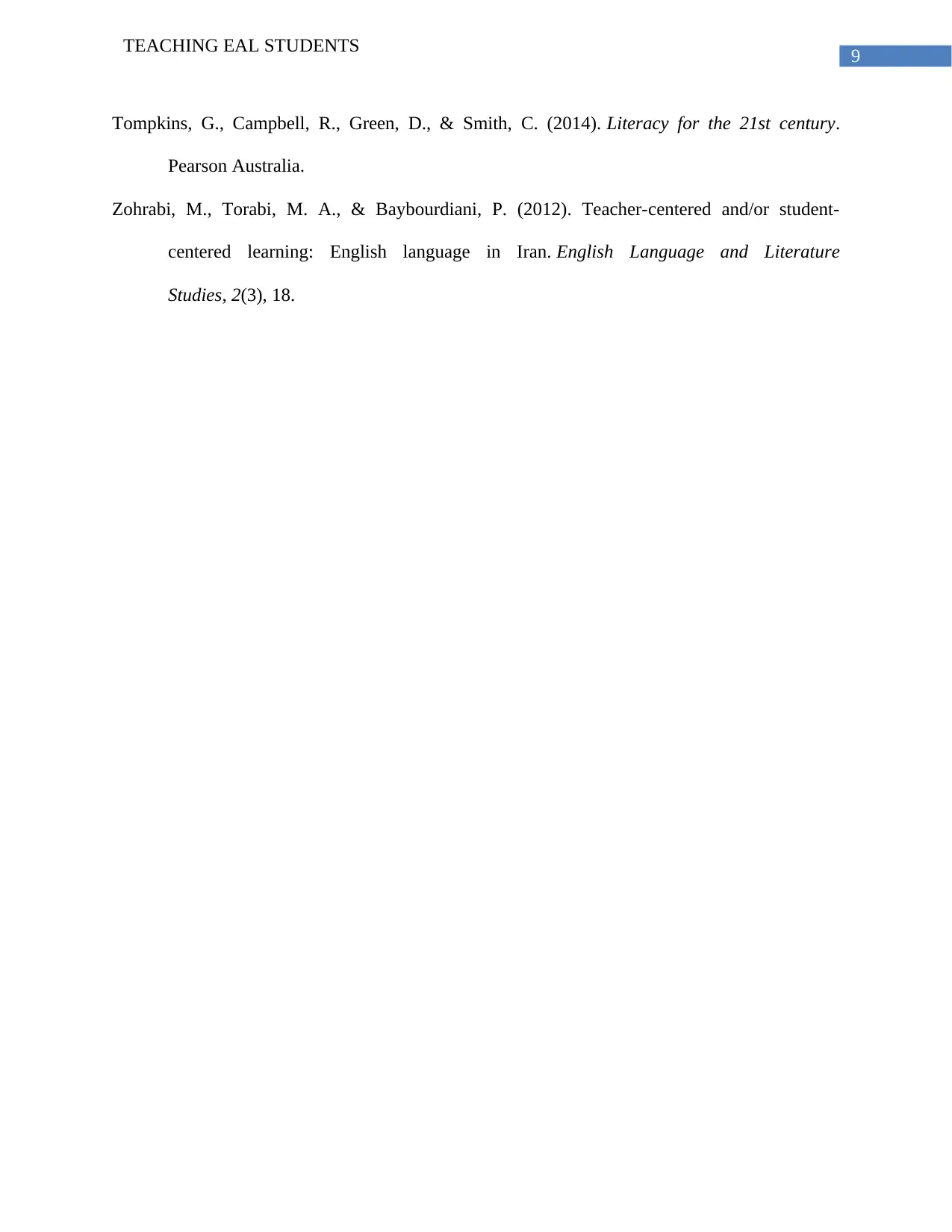
9
TEACHING EAL STUDENTS
Tompkins, G., Campbell, R., Green, D., & Smith, C. (2014). Literacy for the 21st century.
Pearson Australia.
Zohrabi, M., Torabi, M. A., & Baybourdiani, P. (2012). Teacher-centered and/or student-
centered learning: English language in Iran. English Language and Literature
Studies, 2(3), 18.
TEACHING EAL STUDENTS
Tompkins, G., Campbell, R., Green, D., & Smith, C. (2014). Literacy for the 21st century.
Pearson Australia.
Zohrabi, M., Torabi, M. A., & Baybourdiani, P. (2012). Teacher-centered and/or student-
centered learning: English language in Iran. English Language and Literature
Studies, 2(3), 18.
1 out of 10
Related Documents
Your All-in-One AI-Powered Toolkit for Academic Success.
+13062052269
info@desklib.com
Available 24*7 on WhatsApp / Email
![[object Object]](/_next/static/media/star-bottom.7253800d.svg)
Unlock your academic potential
Copyright © 2020–2025 A2Z Services. All Rights Reserved. Developed and managed by ZUCOL.





